The Lao people are a Tai ethnic group native to Southeast Asia, who speak the eponymous language of the Kra–Dai languages, originating from present-day southern China. They are the majority ethnic group of Laos, making up 53.2% of the total population. The majority of Lao people adhere to Theravada Buddhism. They are closely related to other Tai peoples, especially with the Isan people, who are also speakers of Lao language, but native to neighboring Thailand.

The Shan people, also known as the Dai or Tai Yai, are a Tai ethnic group of Southeast Asia. The Shan are the biggest minority of Burma (Myanmar) and primarily live in the Shan State of this country, but also inhabit parts of Mandalay Region, Kachin State, and Kayin State, and in adjacent regions of China, Laos, Assam and Thailand. Though no reliable census has been taken in Burma since 1935, the Shan are estimated to number 4–6 million, with CIA Factbook giving an estimate of five million spread throughout Myanmar which is about 10% of the overall Burmese population.

Mount Tai is a mountain of historical and cultural significance located north of the city of Tai'an. It is the highest point in Shandong province, China. The tallest peak is the Jade Emperor Peak, which is commonly reported as being 1,545 meters (5,069 ft) tall, but is officially described by the PRC government as 1,532.7 meters (5,029 ft) tall.
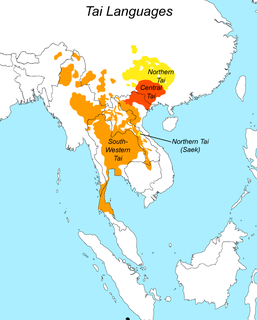
The Tai or Zhuang–Tai languages, are a branch of the Kra–Dai language family. The Tai languages include the most widely spoken of the Tai–Kadai languages, including Standard Thai or Siamese, the national language of Thailand; Lao or Laotian, the national language of Laos; Myanmar's Shan language; and Zhuang, a major language in the Southern Chinese province of Guangxi.

Von Kármán is a large lunar impact crater that is located in the southern hemisphere on the far side of the Moon. The crater is about 180 km (110 mi) in diameter and lies within an immense impact crater known as the South Pole–Aitken basin of roughly 2,500 km (1,600 mi) in diameter and 13 km (8.1 mi) deep. Von Kármán is the site of the first soft-landing on the lunar far side by the Chinese Chang'e 4 spacecraft on 3 January 2019.
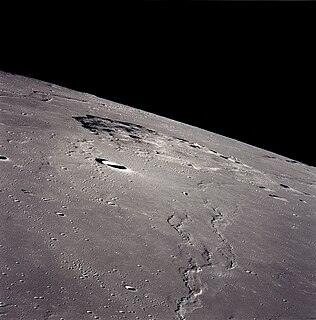
Mons Rümker is an isolated volcanic formation that is located in the northwest part of the Moon's near side, at selenographic coordinates 40.8° N, 58.1° W. The feature forms a large, elevated mound in the northern part of the Oceanus Procellarum. The mound has a diameter of 70 kilometres, and climbs to a maximum elevation of about 1,300 metres above the surrounding plain. It was named after Karl L. C. Rümker.

Mons Hadley is a massif in the northern portion of the Montes Apenninus, a range in the northern hemisphere of the Moon. It has a height of 4.5 km (2.8 mi) 14,764 ft (4,500 m) above the adjacent plain and a maximum diameter of 25 km at the base.

Mons La Hire is a solitary lunar mountain in the western Mare Imbrium. It is located to the northeast of the crater Euler, and to the west-northwest of Lambert.

Mons Vinogradov is a rugged massif that is located on the lunar mare where Oceanus Procellarum to the southwest joins Mare Imbrium to the east. There are three primary peaks in this formation, which rise to altitudes of 1.0–1.4 km above the surface. To the east of this rise is the crater Euler, and to the southeast is an area of rugged ground that reaches the Montes Carpatus range. The Carpatus mountain range forms the southwest boundary of the Mare Imbrium.

Mons Bradley is a lunar mountain massif in the Montes Apenninus range, along the eastern edge of the Mare Imbrium. It is located to the west of the crater Conon. To the west of this peak is the Rima Bradley rille.
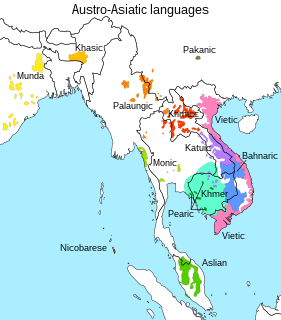
The Vietic languages are a branch of the Austroasiatic language family, spoken by the Vietic peoples in Laos and Vietnam. The branch was once referred to by the terms Việt–Mường, Annamese–Muong, and Vietnamuong; the term Vietic was proposed by La Vaughn Hayes, who proposed to redefine Việt–Mường as referring to a sub-branch of Vietic containing only Vietnamese and Mường.

Thai people, Central Thai or Siamese, in a narrow sense, are a Tai ethnic group dominant in Central and Southern Thailand. Part of the larger Tai ethno-linguistic group native to Southeast Asia as well as Southern China and Northeast India, Thais speak the Central Thai language, which is classified as part of the Kra–Dai family of languages. The majority of Thais are followers of Theravada Buddhism.
The Tai Le script, or Dehong Dai script, is a Brahmic script used to write the Tai Nüa language spoken by the Tai Nua people of south-central Yunnan, China. It is written in horizontal lines from left to right, with spaces only between clauses and sentences.

Tai people refers to the population of descendants of speakers of a common Tai language, including sub-populations that no longer speak a Tai language. There is a total of about 93 million people of Tai ancestry worldwide, with the largest ethnic groups being Dai, Thais, Isan, Tai Yai, Lao, Ahom, and Northern Thai peoples.
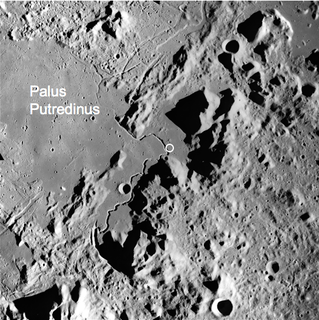
Hadley–Apennine is a region on the near side of Earth's Moon that served as the landing site for the American Apollo 15 mission, the fourth manned landing on the Moon and the first of the "J-missions", in July 1971. The site is located on the eastern edge of Mare Imbrium on a lava plain known as Palus Putredinis. Hadley–Apennine is bordered by the Montes Apenninus, a mountain range, and Hadley Rille, a meandering channel, on the east and west, respectively.
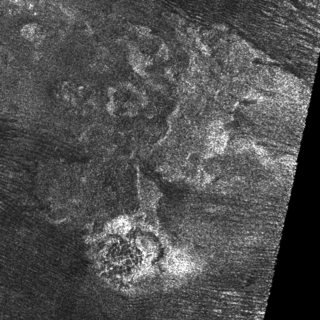
Doom Mons is the name of a mountain range and its eponymous peak on Titan, the largest moon of Saturn. A putative cryovolcano, it is the largest mountain range on Titan by volume, and 4,757 ft (1,450 m) 1.45 km-high peak one of the highest. It was discovered by the Cassini–Huygens probe in 2005 and officially named in 2012.

Mons is a mountain on a celestial body. The term is used in planetary nomenclature: it is a part of the international names of such features. It is capitalized and usually stands after the proper given name, but stands before it in the case of lunar mountains.
Muak Sa-aak is an Angkuic language spoken in the Burma-China border region by over 4,000 people.
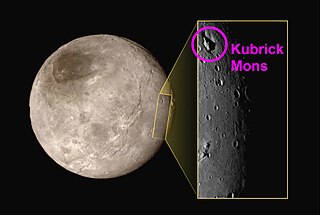
Kubrick Mons is the name given to the largest of a series of mountain peaks on Pluto's moon Charon that rise out of depressions in the Vulcan Planum region. The feature was first recorded by the Long Range Reconnaissance Imager (LORRI) aboard the New Horizons spacecraft during a flyby on 15 July 2015.















